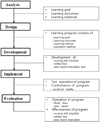Abstract
Purpose
This study was conducted to develop a nurse-learning program for the pain management of cancer patients.
Methods
In this methodological study, a learning program was developed between January and June 2011, following the methodological procedure based on the ADDIE Instructional System Design.
Results
The learning program consists of 4 parts: learning goal, learning outcomes, learning method, and evaluation method. Learner-centered learning goal and learning outcomes were established, and lecture-based group learning and self-directed study were combined as the learning method. For the evaluation, we developed a written test, a nursing skill checklist, and a case report evaluation tool. After a pilot test, the learning program was assessed by an expert group for its construct validity and content-related conformance. Moreover, the effectiveness of the program was validated by the results of the learning outcomes evaluation and the achievement levels of 40 trainees who participated in the program.
Conclusion
On the basis of the results of this study, we suggest that this unit-based core nursing practice learning program, comprising 202 nursing units developed by a research institute nursing department since 2010, be shared by all nurses in clinical nursing care settings to improve their practical performance and ensure necessary specialization.
Figures and Tables
References
1. Yang NY, Moon SY. A study on the relationship of self-directed learning with job satisfaction and organizational commitment of nurses. J Korean Acad Nurs Adm. 2007; 13:473–480.
2. Kim HJ. The effect of feadiness to self-directed learning on employee's Job performance [dissertation]. Seoul: Korea Univ.;2004.
3. Guglielmino PJ, Guglielmino LM. Moving towarda distributed learning model based on self-managed learning. SAM Adv Manag J. 2001; 66:36–43.
4. Adamson KA. Integrating human patient simulation to nursing curriculum. Clin Simul Nurs. 2009; 5:e129–e155.

5. O'Shea E. Self-directed learning in nurse education: a review of the literature. J Adv Nurs. 2003; 43:62–70.
6. Fisher M, King J, Tague G. Development of a self-directed learning readiness scale for nursing education. Nurse Educ Today. 2001; 21:516–525.

7. Choi JH, Jeong JH. The Effect of readiness to self-directed learning on nursing practice competence. J Korean Clin Nurs Res. 2011; 17:16–26.
8. Kim HS. The nature of theoretical thinking in nursing. 3rd ed. New York, NY: Springer Publishing Company;2010.
9. Benner P, Tanner CA, Chesla CA. Expertise in nursing practice caring, clinical judgment & ethics. 2nd ed. New York, NY: Springer Publishing Company;2009.
10. Kim BK, Park JY. A study on assessment method of program outcomes. J Eng Educ Res. 2008; 11:46–57.

11. Cennamo K, Kalk D. Real world instructional design. Toronto, Canada: Wadsworth Publishing Company;2005.
13. In : Kim HS, editor. Nursing practice; a model and its components for knowledge development and advancing practice. Proceedings of the 2013 The Research Institute of Nursing Science College of Nursing Seoul National University; 2013 June 25; Seoul, Korea. The Research Institute of Nursing Science College of Nursing Seoul National University;2013.
14. Rawal N, Hylander J, Arner S. Management of terminal cancer pain in Sweden: a nationwide survey. Pain. 1993; 54:169–179.

15. Kim YH, Jun MH, Gong SH, Choi JS, Jung JY. Implication and evaluation of pain monitoring program for oncology nurses. J Korean Acad Soc Nurs Educ. 2006; 12:196–204.
16. Min YC, Oh PJ. A meta-analysis of intervention studies on cancer pain. J Korean Oncol Nurs. 2011; 11:83–92.

17. Cho MS, Kwon IG, Kim HS, Kim K, Ryu E. Identification and validation of symptom clusters in patients with hepatocellular carcinoma. J Korean Acad Nurs. 2009; 39:683–692.

18. Lee D, Paulus TM, Loboda I, Phipps G, Wyatt TH, Myers CR, et al. A faculty development program for nurse educators learning to teach online. TechTrends. 2010; 54:20–28.

19. Johnson BL, Gross J. Handbook of oncology nursing. Boston: Jones & Bartlett Publishers;2007.
20. Kim KS, Kim JA, Ahn JW. Development and implementation of a self-directed critical care nursing e-learning program. Perspect Nurs Sci. 2012; 9:51–60.
21. Kim YM, You MS, Cho YH, Park SH, Nam SN, Park MO, et al. Development and evaluation of a patient safety-focused inservice education program for surgical nurse. J Korean Acad Nurs Adm. 2010; 16:152–161.

22. Ryu SH. Development of practical arts teaching and learning materials based on concept attainment teaching mode. J Korean Pract Arts Educ. 2010; 12:323–345.
23. Heo H, Kang E. Research trend of Web 2.0 use in education. J Korean Assoc Comput Educ. 2010; 13:59–70.
24. Leem JH. Smart Learning based on Mobile. In : Proceedings of the 2011 Korean Association for Educational Information and Media; 2011 April; Seoul, Korea. Korean Association for Educational Information and Media;2011.




 PDF
PDF ePub
ePub Citation
Citation Print
Print








 XML Download
XML Download